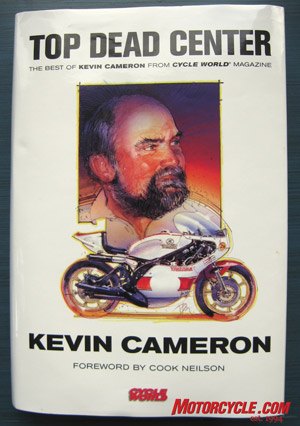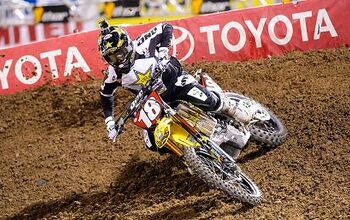Book Review: Top Dead Center
Top Dead Center
By Kevin Cameron
Motorbooks, Copyright 2007
320 pages, B&W illustrations/photos
I am guilty of performing dubious surgeries on internal combustion engines. In retrospect it is surprising how many miles I was able to travel running on ignorance, luck, and brute force. Before reading Kevin Cameron’s earlier work, Sportbike Performance Handbook, I only considered the basics of how an engine works. Squish zones? Back pressures? $^@#, I just wanted it to run! I immediately appreciated Cameron’s skill as a technical writer, having struggled with the challenge of explaining a technical concept to a slack-jawed/glassy-eyed audience. Cameron’s conspiratorial tone soon infected me with the desire to lift the curtain on a host of subjects that would at first glance appear dull
That is the “technical” Cameron you may already be acquainted with. Top Dead Center has that. It also has the indelible sense of a personality in it – foibles, humor, disasters, distractions. And, most over-riding of all, passion. We take a journey in time in this book. Many years, many scored pistons. At no time do you sense the passion is truly in jeopardy, however. In Cameron’s words the series of TDC columns that formed the backbone of this book were a “monthly letter to like-minded persons.”
The book begins by taking us all racing. Racing! The smell of race gas, the shriek of intakes, the colors and flash of a racer blurring past – all are present yet are rendered transparent by Cameron’s literary eye. He allows us to see – with X-ray vision – the air sucked into the intake, to slow down the next to instantaneous impulse of a piston’s travel. We feel the sense of urgency as the piston progresses – intake, the dance of fuel and air, the compression stroke and the flash of ignition, heat and force. The roar of the exhaust, though, is still shared by the roar of the crowd. A microscope, while a powerful and clinical tool, usually doesn’t allow us the macro view. Cameron’s take on racing does. It isn’t all sweetness and light, though. Part of the ride also involves stiff necks from sleeping in vans, eating bad food at the track, harsh financial realities, and resisting the urge to throttle teammates.
In the next section Cameron explores the metallurgy of a champion racer. Kenny Roberts takes a corner differently than Freddie Spencer, and Cameron lets us understand why. But this is no dry treatise on riding styles. In a champion’s words about recovering from a painful crash: “There’s no comeback,” he [Gary Nixon] says. “I was never away.” Soon, though, you wonder why he didn’t run from the troubles in threes: awarded prize money snatched back, motorcycles lost in the mail and stolen luggage.
In rider interviews Cameron underlines one basic prerequisite of a champion racer: the indomitable will to conquer, whether it’s personal demons, injuries, other riders, their own machines, or the clock. Less obvious are the mental demands of racing – the mental aspects are highlighted in an early interview with Kenny Roberts. But even being able to think clearly at high speed is still not enough; adapting to constant technological change must be accomplished as well. We see that, as the book travels through time, obsolescence stalks both man and machine.
The next section turns us from the people on the machine to the people behind the machines. The alchemists of a racing machine; “...that diffuse amalgam of power, power band, handling, weight, and unity that turn a thousand metal pieces into a fine tool for a skilled rider.” The ingredients may be timeless, but nowhere are we more aware of the passage of technological time than in this section titled “Moguls, Mavens, and Mechanics.”
These are the people that have the skill, vision, and grit to change “the way things are.” If you ride a motorcycle today, then you will find the influences of the people in this section represented somewhere on your bike. “Why build your own engine in a world full of attractive designs? Because, like the Wright brothers, Britten wasn’t satisfied with what was available, and believed he could do better.”
Dreams are the recurring theme in this section. Britten’s “unifying aesthetic” is one type of dream. A different dream is represented in the story of the Dentist’s Guzzi, or in the oil and water mix of Buell and his corporate partner, the staid Harley-Davidson Motor Company.
Though we see the individual, Cameron also lets it be known that no technical effort of this complexity is a one-man-show. “Only in Jules Verne’s fiction does one genius scientist-engineer mine the ore, smelt the alloy, draw the tubing, and finally build the vehicle – all on his own.”
In the first three sections we experienced the racing life, interviewed the racers, and asked the probing questions of the people behind the machines. In the final section, “Inner Workings,” we return home to Cameron’s workshop. Through all of this, Cameron’s medium is his thousand-word column in Cycle World, “TDC.” “’TDC’ was originally intended to be a technical column that explained things like how to extend the life of your battery or wheel bearings. That’s limited, so I began to write about experiences that all motorcycle people have,” wrote Cameron.
“Motorcycle people” are going to enjoy this book. Cameron has picked what he feels is his best for this compilation. Thirty years is enough time to see everything old as new again: four-stroke racing becomes two-stroke, two-stroke back to four-stroke, and we also see some of the same flawed reasoning employed in the attempt to add safety to racing. Yesterday’s champion is supplanted by today’s rookie, but the perspective brought by Cameron’s 30 years of close association let’s us derive the best of all – a sense of continuity.
On the critical front, this book is regrettably under-illustrated. Cameron must have taken more pictures! Where are they? The fact that this is a compilation doesn’t allow a narrative flow to the book, outside the brief introductions that Cameron supplements each of the “TDC” columns with. Finally, if you are struggling with carburetor jet selection or you need to understand airbox resonance, then Sportbike Performance Handbook is the Cameron book you seek.
TDC is instead a chance to remember the smell of race gas on a cold winter’s night. It is a trip through time that is refreshingly unburdened by nostalgia or bitterness. In the end it left me with the hope that Kevin Cameron eats his vegetables, as I am looking forward to the next compilation 30 years from now.
Salute!
Related Reading
"Everything You Need To Know About Streetbikes” Book Review
DVD Review: "Twiddling Knobs"
Book Review: Sportbike DIY
More by User
































Comments
Join the conversation